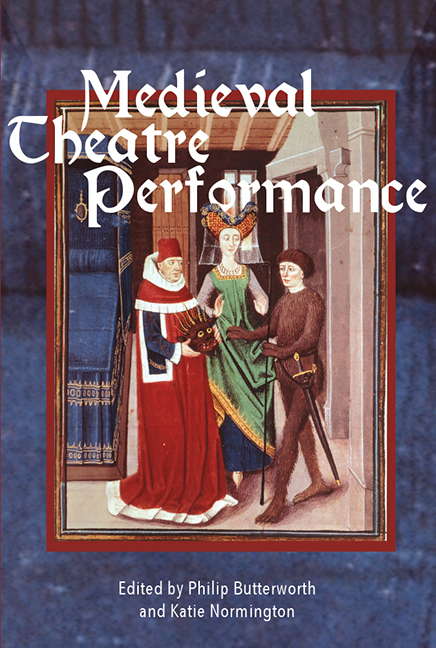Book contents
- Frontmatter
- Dedication
- Contents
- List of Illustrations
- Contributors
- Abbreviations of Principal Sources Cited
- Introduction
- Synopses
- 1 From Archive to Repertoire: The Disguising at Hertford and Performing Practices
- 2 Walk, Talk, Sit, Quit? On What Happens in Netherlandish Rhetoricians’ Plays
- 3 Performing Intrusions: Interaction and Interaxionality in Medieval English Theatre
- 4 Player Transformation: The Role of Clothing and Disguise
- 5 Pavilioned in Splendour: Performing Heaven in Fifteenth-Century Florence
- 6 Living Pictures: Drama without Text, Drama without Action
- 7 Performer-Audience Relationships in Fifteenth- and Sixteenth-century Danced Spectacles
- 8 Decadance in the Late Middle Ages: The Case of Choreomania
- 9 Writing, Telling and Showing Horsemanship in Rhetoricians’ Farce
- 10 Inanimate Performers: The Animation and Interpretive Versatility of the Palmesel
- 11 ‘lyke unto a lyvelye thyng’: The Boxley Rood of Grace and Medieval Performance
- 12 The Mechanycalle ‘Ymage off Seynt Iorge’ at St Botolph's, Billingsgate, 1474
- Bibliography
- Index
5 - Pavilioned in Splendour: Performing Heaven in Fifteenth-Century Florence
Published online by Cambridge University Press: 21 August 2018
- Frontmatter
- Dedication
- Contents
- List of Illustrations
- Contributors
- Abbreviations of Principal Sources Cited
- Introduction
- Synopses
- 1 From Archive to Repertoire: The Disguising at Hertford and Performing Practices
- 2 Walk, Talk, Sit, Quit? On What Happens in Netherlandish Rhetoricians’ Plays
- 3 Performing Intrusions: Interaction and Interaxionality in Medieval English Theatre
- 4 Player Transformation: The Role of Clothing and Disguise
- 5 Pavilioned in Splendour: Performing Heaven in Fifteenth-Century Florence
- 6 Living Pictures: Drama without Text, Drama without Action
- 7 Performer-Audience Relationships in Fifteenth- and Sixteenth-century Danced Spectacles
- 8 Decadance in the Late Middle Ages: The Case of Choreomania
- 9 Writing, Telling and Showing Horsemanship in Rhetoricians’ Farce
- 10 Inanimate Performers: The Animation and Interpretive Versatility of the Palmesel
- 11 ‘lyke unto a lyvelye thyng’: The Boxley Rood of Grace and Medieval Performance
- 12 The Mechanycalle ‘Ymage off Seynt Iorge’ at St Botolph's, Billingsgate, 1474
- Bibliography
- Index
Summary
Fifteenth-century Florence was a city abuzz with new humanistic ideas but still profoundly attached to the texts and images and piety of the late Middle Ages. From the 1420s onwards, three laudesi [hymn-singing] confraternities founded in the fourteenth century in the Oltrarno, Florence's ‘Left Bank’, each took responsibility for performing a spectacle to mark the principal feast day of their respective churches. The primary purpose of these confraternities of adult men, mostly artisans, was to sing vernacular hymns [laude] to the glory of God and the Virgin. They employed professional singers to assist and train them, and much of their effort must have been for their own pleasure in singing together on a daily basis. But by the 1440s, all three confraternities were investing considerable effort in celebrating the principal feast day of their church with a festa or performance.
Leaving aside the more famous Annunciation in San Felice, this chapter will examine the Ascension and Pentecost feste performed annually by the confraternities of Santa Maria delle Laudi e di Sant'Agnese, which met in the Carmelite church of Santa Maria del Carmine, and of Santa Maria delle Laudi e dello Spirito Santo, which met in the Augustinian church of Santo Spirito. It will argue that the actual events on the Thursday of Ascension and ten days later on the Sunday of Pentecost were only a small part of the performance; rather, the whole production process should be seen in terms of performance, from the annual purchase of new keys, rat-poison and brooms through to the celebratory dinner that followed the festa. The confraternities owned their feste from beginning to end and their shape was determined not by the finality of their spoken text but by a collective process, their knowledge of how such things were done.
The material that allows us to reconstruct this process is contained for the most part in confraternal account books, inventories and meeting-records, which escaped the Leopoldine suppression of confraternities in 1785 and which entered the State Archives in Florence in 1861 following Unification and the renewed secularisation of church property.
- Type
- Chapter
- Information
- Medieval Theatre PerformanceActors, Dancers, Automata and their Audiences, pp. 93 - 106Publisher: Boydell & BrewerPrint publication year: 2017

